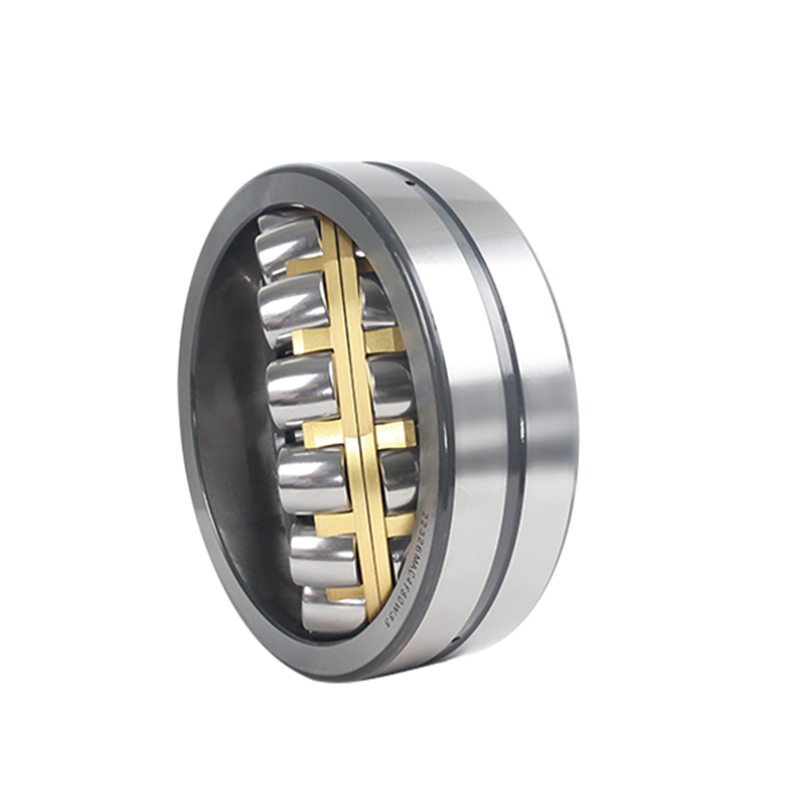Apr . 15, 2024 12:14 Back to list
Selected case studies of bearing damage modes
9.9.1 Micropitting of main shaft spherical roller bearings
Spherical roller bearings are typically used to support the main shafts in current wind energy turbine modular designs because of their ability to accommodate misalignment between the shaft and the bearing housing. Frictional shear stress increases the bulk contact stress values and brings the maximum values closer to the surface, allowing these localized stresses under the asperity contacts to become significant [53] enough to initiate cracks that propagate and create micrometer-sized pits.
Analyses of the typical radial and axial forces on a main shaft spherical roller bearing performed by Ionescu and Pontius [51,54] indicate that the entire load is supported by the downwind row while the upwind row of the bearing is essentially unloaded. This situation results in higher loads on the downwind row, as well as a full 360 degrees loaded arc of rollers, which increases the number of stress cycles occurring on a point on the inner raceway for every shaft revolution. Since the main shaft typically rotates at speeds in the 25–35 rpm range, significant lubricant film thicknesses are not developed in the contact. Additionally, rollers will exhibit sliding on the downwind row raceway in these bearings owing to the Heathcoat slip effect, a geometrical constraint suffered by all spherical roller bearings. The combination of Heathcoat slip, higher loads, more stress cycles, and thinner lubricant film thickness on the downwind row creates an environment conducive to micropitting.
As addressed in Chapter 7, micropitting originates by a surface-initiated fatigue mechanism where cracks initiate due to the pile up of dislocations at plastically deformed region boundaries. It follows that technologies designed to inhibit or mitigate plastic deformations of asperities will be beneficial in solving micropitting damage problems encountered by rolling element bearings. The low entrainment speeds of the mainshaft spherical roller bearings are insufficient to generate lubricant films thick enough to separate the asperities on the rolling elements and raceways even with very high viscosity greases. Therefore, surface engineering remains the most promising strategy to reduce the asperity-asperity interactions that promote micropitting damage.
Black oxide (magnetite) surface treatments applied to the rings and rolling elements have been reported to exhibit micropitting wear protection [55–58]. When used on rolling bearing surfaces, magnetite wears abrasively until either the Fe3O4 is removed, or the abrasive wear rate of the magnetite becomes vanishingly small. The situation where the abrasive wear rate vanishes corresponds to the lubrication regime transitioning beyond boundary layer to a condition where the lubricant film effectively separates the contacts. If the black oxide surface treatment can effectively transition the lubrication regime to a situation where the asperities on the rolling elements and raceways are no longer in contact before being worn away, then the black oxide will be effective at mitigating micropitting damage.
Another surface engineering technology that is effective at addressing micropitting wear is the use of hard coatings on the rolling elements. Diamondlike carbon coatings like the W-DLC described in previous chapters have been cited for their ability to defeat the micropitting wear mechanism in rolling bearings [59–62]. For example, W-DLC coatings are more than 50% harder than bearing steel, so they not only effectively separate the steel asperities, but they also polish the uncoated surface. This polishing action increases the lambda value and explains why it is more beneficial to apply the coating to only one of the contacting surfaces.
A direct comparison between the antimicropitting potential of a black oxide surface treatment and a W-DLC coating has been provided by Mahmoudi et al. [59]. In this study, it was observed that if the black oxide could transition the lubrication regime in the contact to a situation where asperity contact was effectively reduced, then black oxide surface treatments can inhibit micropitting. If the black oxide wore away before the lubrication regime could be significantly improved, micropitting would occur although its onset was delayed. On the other hand, the study showed that the W-DLC coating remained on the rolling element throughout the experiment and micropitting did not occur.
Both of these surface engineering technologies are now widely used on wind turbine mainshaft spherical roller bearings. Although the use of W-DLC-coated rollers in these bearings perform much better at addressing micropitting wear, bearings with this coating cost more than similar bearings with a black oxide surface treatment. An image of a main shaft spherical roller bearing with W-DLC coatings on the rollers is shown in Fig. 9.7.
Latest news
-
Top Spherical Roller Bearing Material Exporter - High-Performance Alloys
NewsAug.27,2025
-
Durable PLC 110-190 Spherical Roller Bearing for Mixer Reducer
NewsAug.26,2025
-
CSK-2RS Sprag Clutch One Way Bearing: Sealed, High Torque, Durable
NewsAug.25,2025
-
CKZ-D Series One Way Overrunning Clutch: Reliable Power Control
NewsAug.24,2025
-
203KRR3 Round Bore Series Bearings | Cylindrical Outer Ring, Precision
NewsAug.23,2025
-
Top Spherical Roller Bearing Material Exporter - High Performance
NewsAug.22,2025
